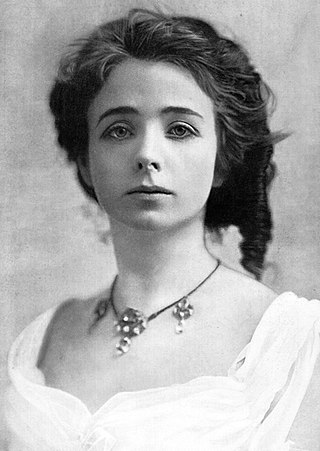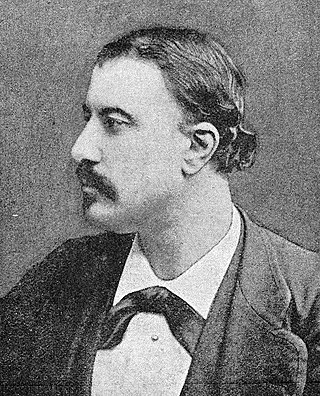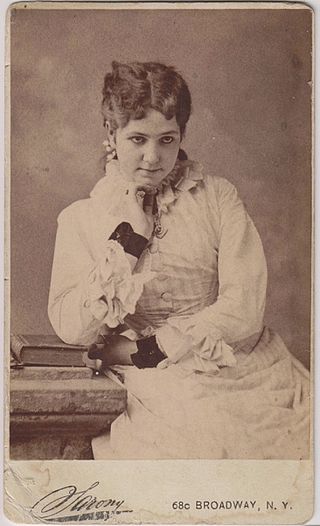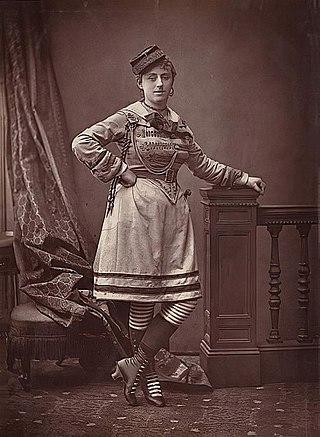Related Research Articles

Anne Hartley Gilbert professionally billed as Mrs. G. H. Gilbert was a British actress.

Maude Ewing Adams Kiskadden, known professionally as Maude Adams, was an American actress and stage designer who achieved her greatest success as the character Peter Pan, first playing the role in the 1905 Broadway production of Peter Pan; or, The Boy Who Wouldn't Grow Up. Adams' personality appealed to a large audience and helped her become the most successful and highest-paid performer of her day, with a yearly income of more than one million dollars during her peak.

Charles Strouse is an American composer and lyricist best known for writing the music to such Broadway musicals as Bye Bye Birdie, Applause, and Annie.

Edwin Adams was an American stage actor, considered to have been one of America's best light comedians.

Frederic Emes Clay was an English composer known principally for songs and his music written for the stage. Although from a musical family, for 16 years Clay made his living as a civil servant in HM Treasury, composing in his spare time, until a legacy in 1873 enabled him to become a full-time composer. He had his first big stage success with Ages Ago (1869), a short comic opera with a libretto by W. S. Gilbert, for the small Gallery of Illustration; it ran well and was repeatedly revived. Clay, a great friend of his fellow composer Arthur Sullivan, introduced the latter to Gilbert, leading to the Gilbert and Sullivan partnership.

The Black Crook is a work of musical theatre first produced in New York City with great success in 1866. Many theatre writers have cautiously identified The Black Crook as the first popular piece that conforms to the modern notion of a musical. The book is by Charles M. Barras. The music, selected and arranged by Thomas Baker, consists mostly of adaptations, but it included some new songs composed for the piece, notably "You Naughty, Naughty Men". The story is a Faustian melodramatic romantic comedy, but the production became famous for its spectacular special effects and skimpy costumes.

Annie Ellen Russell was a British-American stage actress.

William Wheatley was an American stage actor.

Evangeline Estelle Gazina, better known under her stage name, Kate Santley, was a German-born actress, singer and comedian. After spending her childhood in the US, she came to England in 1861, where she had a successful career, later also becoming a theatre manager.

Pauline Markham was an Anglo-American dancer and contralto singer active on burlesque and vaudeville stages during the latter decades of the 19th century. She began by performing juvenile rôles in Manchester, made her debut on the London stage at 20 and a year later New York as a member of the British Blondes which introduced Victorian burlesque to America, where for a few years she would find phenomenal success before her career settled into a long steady decline.

Anna de Belocca was a Russian-born operatic contralto.

Oswald Yorke(néeOswald Parkinson Harker; 24 November 1866 – 25 January 1943) was a British character actor who had a near sixty-year career performing on both sides of the Atlantic.

Emily Rigl was a 19th-century stage actress who primarily performed in the United States. Although not a major star, she was considered to be a talented actress.

Marie Jansen was an American musical theatre actress best known for her roles at the end of the 19th century. She starred in a number of successful comic operas, Edwardian musical comedies, and comic plays in New York, Boston, Philadelphia and London during the 1880s and 1890s.

Jane Peyton was an American lead and supporting actress whose career did not commence until she was nearly 30. During her time on stage, she appeared in several long-running Broadway plays and successful road tours. Peyton is remembered for her performances in The Ninety and Nine, The Earl of Pawtucket, The Heir to the Hoorah, The Three of Us, and The Woman. Once the wife of actor Guy Bates Post, Peyton retired after 14 years on stage, when she married the writer Samuel Hopkins Adams.

Jennie Kimball was an American actor, soubrette, and theatrical manager.

Bessie Sudlow was the stage name of Barbara Eliza (Bessie) Johnstone, active in the United States as a burlesque performer from 1867 to 1874, then in Britain as an opera bouffe soprano from 1874 to 1880.

Linda Verner was a British singer and actress of the Victorian era who appeared in operetta, pantomime, Victorian burlesque and other comic and musical works in London and on tour in Britain and abroad from the 1870s to the early 1890s.

Jarrett & Palmer was an American theatrical production partnership, prominent and influential in the 1860s and 1870s.

Marie Eugenia von Elsner, known by her stage name Marie Litta, was an American soprano opera singer.
References
- 1 2 (August 24, 1876). Death of the Original "Stalacta", Evening Star (Washington, D.C.), p. 1, col. 7.
- ↑ (30 December 1876). Dramatic Diary - Incidents of the Past Six Months, New York Tribune
- ↑ (29 October 1877). Death of Mr. Edwin Adams, The New York Times (notes Bowler as among those interred there)
- ↑ Adams, W. Davenport. A dictionary of the drama, Vol. I, p. 8 (London 1904)
- ↑ The History of the Boston Theatre, 1854-1901, p. 144 (1908)
- ↑ Brown, T. Allston. A History of the New York Stage from the First Performance in 1732 to 1901 (1902)
- ↑ Hutton Lawrence. Plays and Players, p. 230 (1875)